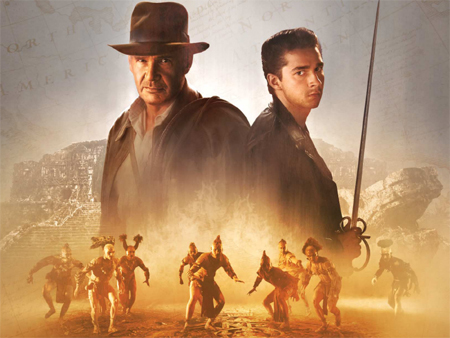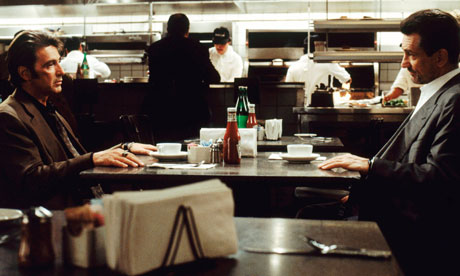It has now been nineteen years since the third and (apparent) final installment of Indiana Jones hit theatres. In 1989, it appeared that Indiana had partaken in his final adventure (in Indiana Jones and the Last Crusade) as the whip-cracking hero. However, after numerous story ideas and a revolving door of screenwriters, the series has finally struck back with a vengeance in 2008.
Indiana Jones and the Kingdom of the Crystal Skull is the embodiment of what a summer movie should be. Action, adventure, comedy and preposterous plots help to define what a summer movie is, and these categories truly hold meaning for this film. Yet for all the action that is included, there is a limited use of computer generated imagery (CGI) present. In more ways then one, the film relies heavily on old school tactics (stunt man as opposed to computer effects) to not so much create a sense of realism, but as to create a sense of nostalgia.
The film truly embraces its past. Just because technology has advanced does not mean it needs to be exploited for the purpose of creating a greater sense of adventure. Indiana Jones works as a result of the audiences’ previous understanding of this character. He is not perfect and is constantly apprehended. He is an accidental hero improvising the steps. Yet, he is more real as a result, and that is what makes him so relatable.
This being said, the film is more then just mindless entertainment. Starring a now 65 year old Harrison Ford, and directed by veteran Steven Spielberg, the Indiana Jones series has become a reinvigorated and fresh adventure to be embraced by everyone.
The Plot of the Crystal Skull
Indiana Jones’ (Harrison Ford) newest adventure begins in the desert Southwest in 1957 — the height of the Cold War. Indy and his sidekick Mac (Ray Winstone) have barely escaped a close scrape with nefarious Soviet agents on a remote airfield. Now, Professor Jones has returned home toMarshallCollege– only to find things have gone from bad to worse. His close friend and dean of the college (Jim Broadbent) explains that Indy’s recent activities have made him the object of suspicion, and that the government has put pressure on the university to fire him.
On his way out of town, Indiana meets rebellious young Mutt (Shia LaBeouf), who carries both a grudge and a proposition for the adventurous archaeologist: If he’ll help Mutt on a mission with deeply personal stakes, Indy could very well make one of the most spectacular archaeological finds in history — the Crystal Skull of Akator, a legendary object of fascination, superstition and fear.
That is all that will be mentioned as it in the viewer’s best interest to discover the wonders of this film firsthand. With this being said, the film does magnificently capture the 1950s era through its focus on the threat of Communism, the Cold War, nuclear bombs, Harley Davidson’s and leather jackets, the emergence of rock n’ roll, greasers, and a new found fascination with U.F.O.’s.
For anyone who has seen an Indiana Jones film, the structure of the plot will not deviate from past experiences. There are chases sequences, vile enemies, disgusting creatures, over-the-top wild action and so on. The film follows the previous three films construction to a tee, but yet stands on its own as a wonderful piece of escapism. One truly gets a sense of wonderment as the action and plot unfolds onscreen.
The Characters of Indiana Jones
Whereas most summer films displace characterization with action, Indiana Jones and the Kingdom of the Crystal Skull has an intent focus on building character relations in association with creating nail-biting tension. As a result, the characters are wonderfully brought to life through a wide arrange of award winning actors (such as John Hurt).
However, it is Cate Blanchett as Irina Spalko that truly mesmerizes the eyes. She is cold and calculating and dominates every frame she is in. She is perhaps one of the strongest female characters in recent memory on the big screen. Blanchett’s acting range can hardly be compared to anyone else at the present moment, and her turn as a truly vindictive villainous adds yet more range to her already impressive resume.
However the film would not survive ten minutes if it were not for Harrison Ford. Ford is not the greatest or most compelling actor ever, but he is extremely charismatic. He magnetically holds the glance of the audience. Not just because he is Indiana Jones, but rather because of his nonchalant approach to playing this now iconic character. He was born for the role.
It would have been a tremendous shame if the film had not lived up to expectations (though it is not a perfect film). Threatening the iconic status of the series with one final showing may have contaminated what had previously come before it. However, the film is extremely entertaining and, though it may not live up to Raiders of the lost Ark (1981), is still a relevant piece of escapist fare. It deserves to be mentioned alongside the previous trilogy as a worthy ally.



